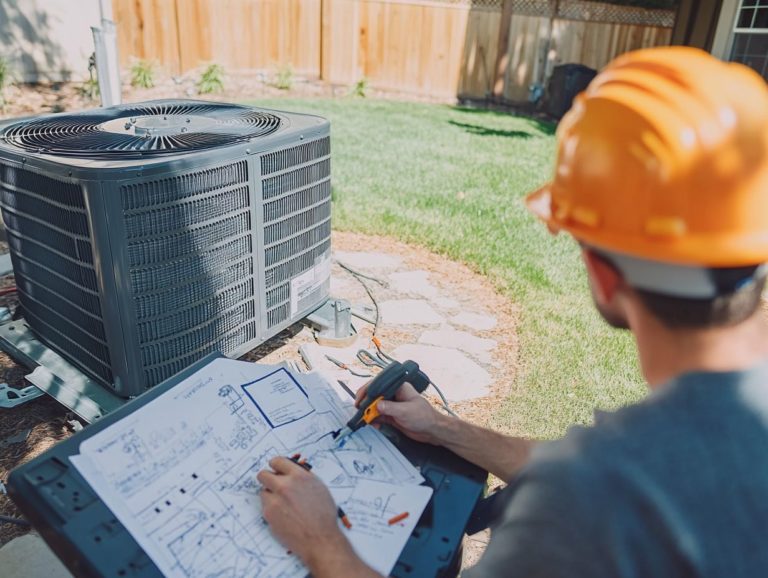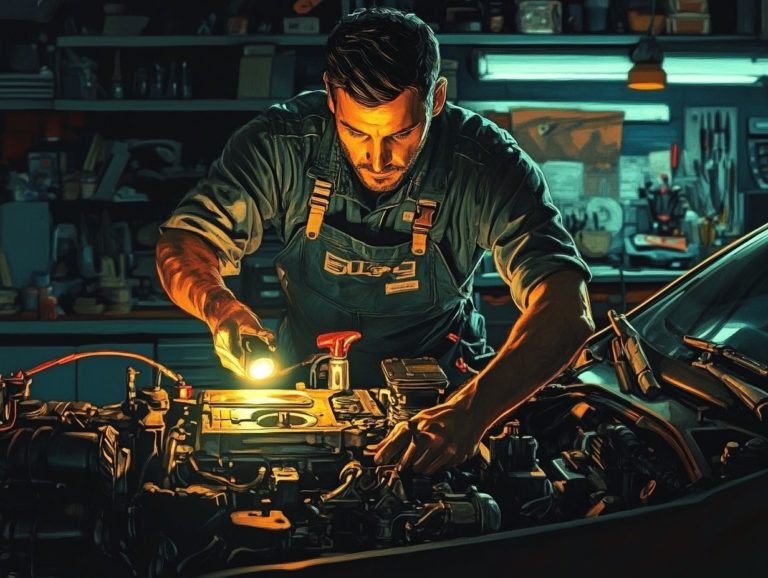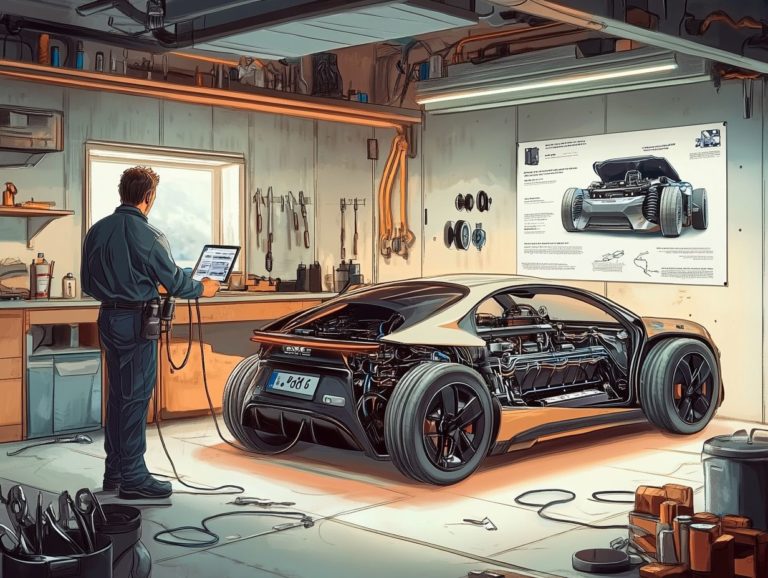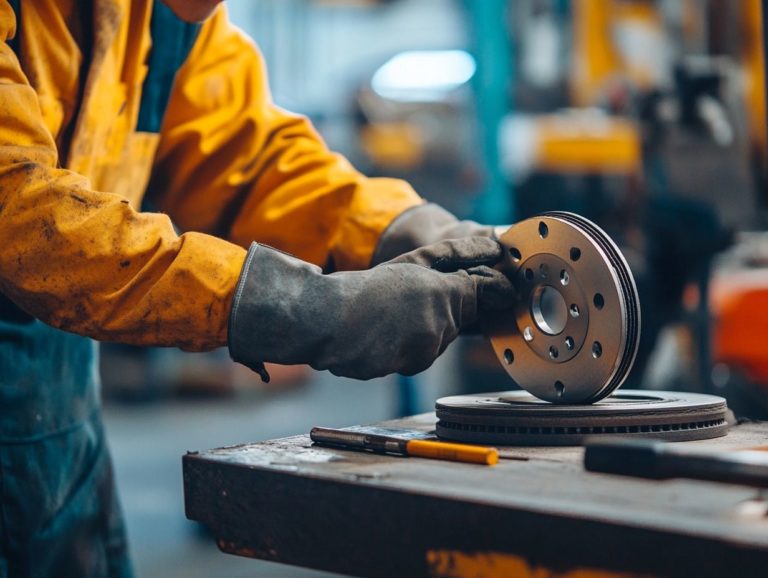Brake Problems: Signs and Common Repairs
Understanding your car’s braking system is crucial for ensuring your safety while driving. This article delves into the common signs of brake problems, enabling you to identify warning signals before they escalate into serious issues.
You ll find insights on various types of brake repairs specifically tailored to address distinct problems. Essential maintenance tips will keep your brakes functioning at their best.
It will also guide you on when to seek professional assistance and offer a step-by-step DIY repair guide for those who enjoy getting their hands dirty.
Boost your knowledge now! Take proactive steps to keep your vehicle safe on the road!
Contents
Key Takeaways:
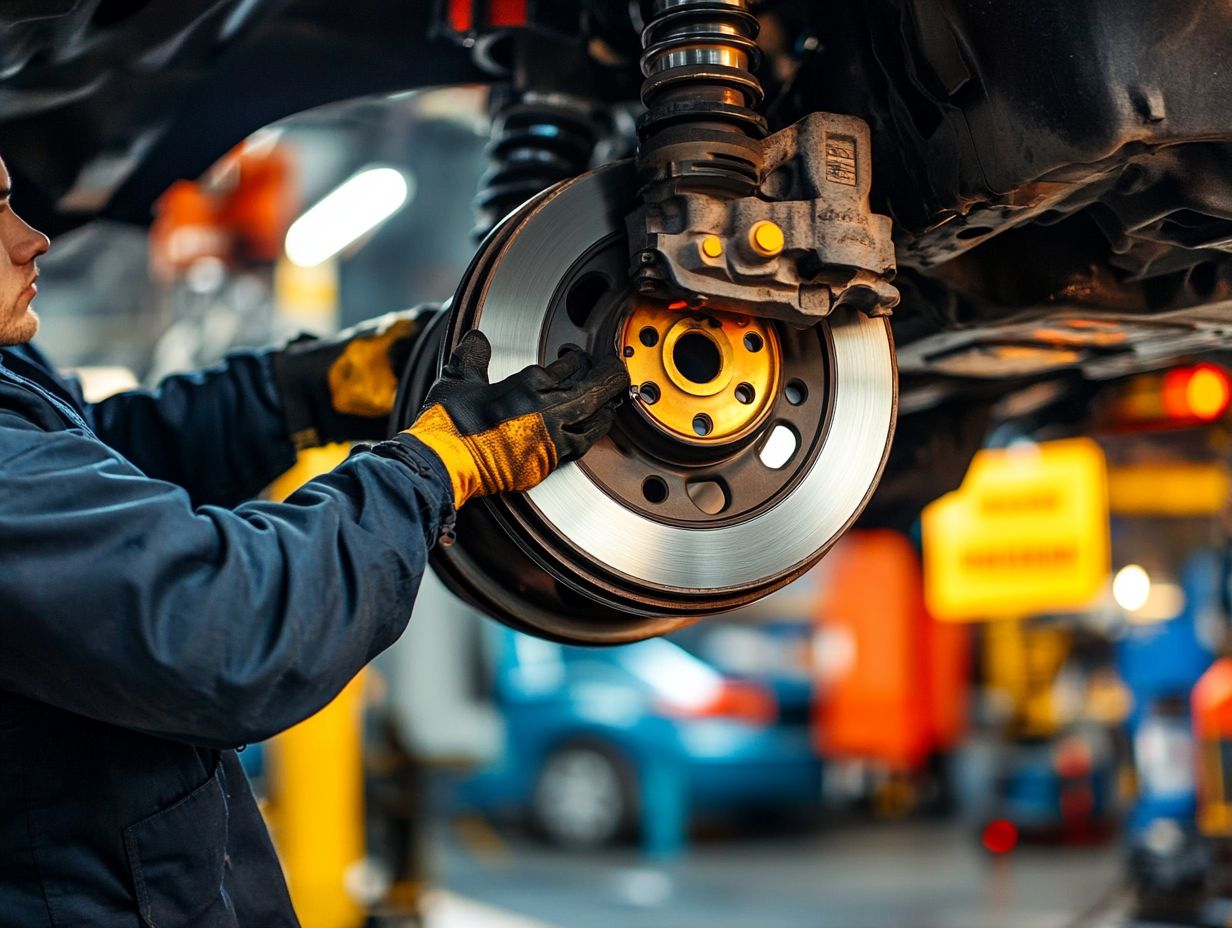
- Pay attention to warning signs such as squealing or vibrating brakes to identify potential brake problems.
- Different brake issues require different repairs, such as replacing worn brake pads or fixing a leak in the brake line.
- Regular maintenance, like checking brake fluid levels and keeping brake components clean, can help prevent common brake problems.
Common Signs of Brake Problems
Recognizing the common signs of brake problems is essential for ensuring your vehicle’s safety and best braking performance. Key warning signs like a soft brake pedal, excessive heat, or the brake warning light illuminating on your dashboard may suggest underlying issues within your brake system. For more details on recognizing common brake issues early, it’s important to stay informed.
Abnormal sounds like grinding or squealing should never be overlooked. These can signal serious brake issues that could compromise your stopping distance and overall braking efficiency.
Identifying Warning Signs
Identifying warning signs is crucial for maintaining your vehicle’s brake system effectively. Regular brake inspections can save you from expensive repairs and potentially dangerous situations on the road.
Some critical warning signs to keep an eye on include any unusual noises, like squeaking or grinding, which may indicate that your brake pads have worn down significantly.
If you notice a pulsating or vibrating sensation when applying the brakes, it could suggest issues with the rotors. Pay close attention to the brake warning light on your dashboard; this means you need to act quickly.
By monitoring these brake wear indicators, you can ensure timely maintenance and significantly enhance your overall driving safety.
Types of Brake Repairs
Understanding the various types of brake repairs is essential for you as a vehicle owner. This knowledge ensures optimal braking performance and safety on the road.
Depending on the diagnosis, your repairs may require replacing brake pads, resurfacing brake rotors, or servicing brake calipers. Each plays a critical role in maintaining the integrity of your brake system.
Moreover, timely brake servicing is vital to prevent more severe issues from neglecting these essential components.
Tailored Repairs for Specific Brake Problems

Different brake issues demand tailored repair strategies to ensure effective resolution and maintain your safety on the road.
Take warped rotors, for example; they can cause unsettling vibrations when you brake. You ll need to consider resurfacing or replacing them to restore that smooth, confident operation.
Then there s brake fade, which can sap your stopping power due to overheating. This often means you ll want to upgrade your cooling system or invest in high-performance brake pads to keep things in check.
It’s essential to keep an eye on your brake fluid levels, as contamination can severely impact the overall functionality of your brakes. Regular checks and timely replacements of brake fluid not only enhance braking efficiency but also prolong the lifespan of various components within your braking system, contributing to a safer driving experience.
Brake Maintenance Tips
Implementing effective brake maintenance tips is essential for extending the life of your braking system and guaranteeing your vehicle’s safety. Regular inspections and keeping an eye on brake fluid levels can help you avoid more serious brake issues in the future. Promptly replacing worn components is also crucial.
Being aware of your driving habits can help you maintain your brakes better and tailor your approach for optimal performance.
Preventing Common Brake Problems
Preventing common brake problems requires a blend of proactive maintenance and mindful driving habits. Regular inspections are crucial for spotting potential issues before they escalate. Create a comprehensive list of things to check on your brakes that includes everything from checking brake fluid levels to examining the condition of the pads and rotors.
Understanding how various driving behaviors like frequent hard braking or aggressive acceleration can significantly influence brake wear is vital. By embracing smoother driving techniques and sticking to maintenance schedules, you can extend the lifespan of your braking system and enhance safety on the road.
When to Seek Professional Help
Understanding when to seek professional assistance for your brake system is essential for your safety and for preventing further damage.
If your brake warning light comes on, or if you notice symptoms like grinding noises or a pulsating brake pedal, it s crucial to consult a professional mechanic without delay. Don t wait! If your vehicle is pulling to one side, get help right away.
Addressing these issues promptly with timely inspections and repairs can save you from expensive brake problems down the line.
Knowing When to Take Your Car to a Mechanic
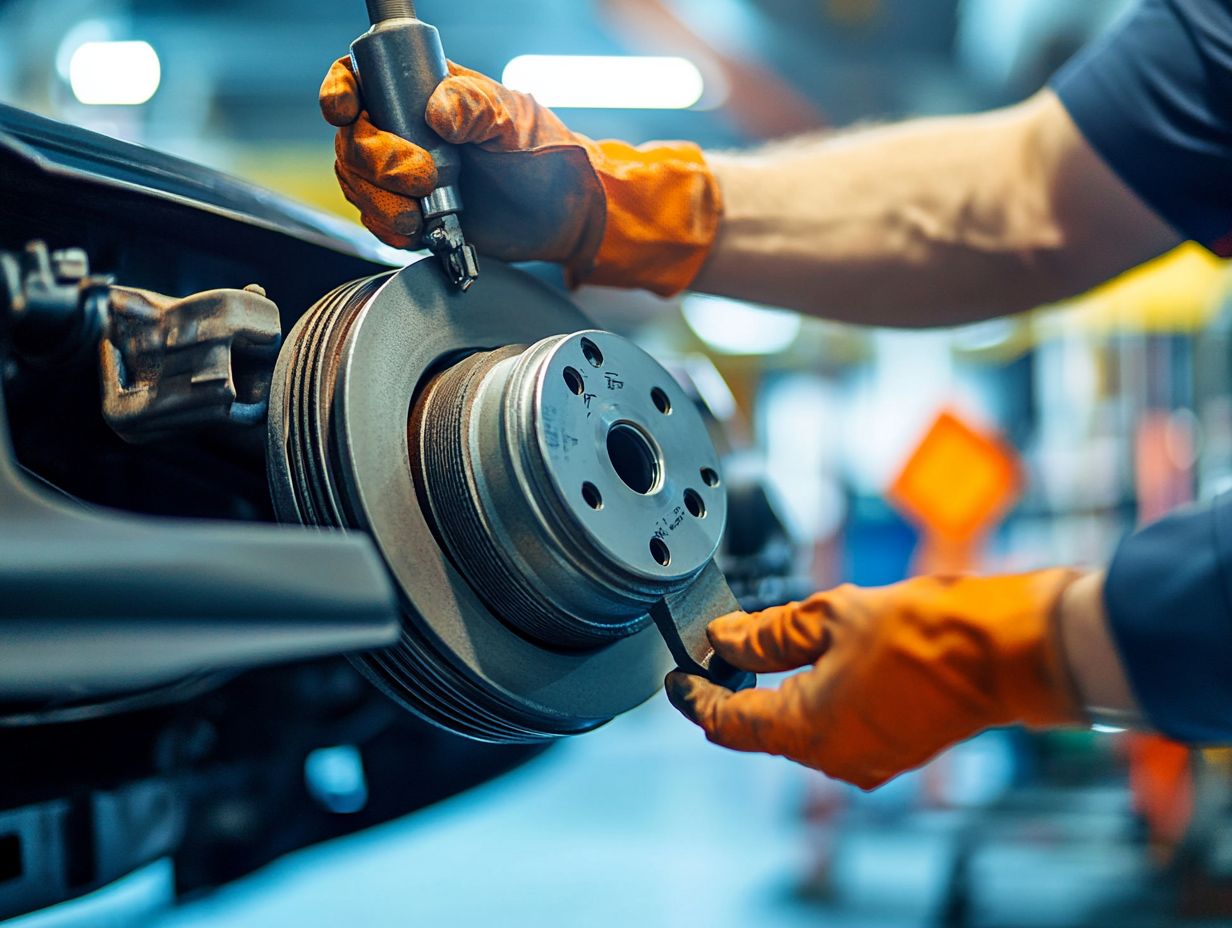
Knowing when to take your car to a mechanic can significantly impact the longevity of your vehicle’s brake system.
Recognizing the early signs of brake issues is essential for both your safety and the maintenance of your car. If you see any dashboard alerts for brake warnings or hear unusual noises like grinding, squeaking, or hissing when you press the brake pedal, you shouldn t ignore them. A soft or spongy brake pedal might indicate that there’s air in the brake lines, while your vehicle pulling to one side could suggest uneven wear on the brake components.
Taking swift action in these situations can help prevent more severe damage and avoid costly repairs, ensuring that your vehicle’s performance and your safety on the road remain intact.
DIY Brake Repairs
Embarking on DIY brake repairs can be a savvy, cost-effective strategy to manage minor issues while ensuring your vehicle’s brake system stays in peak condition. With the right tools and a solid understanding, you can tackle tasks like replacing brake pads or checking brake fluid levels right from the comfort of your home.
However, it s vital to adhere to proper maintenance protocols to steer clear of any potential mishaps. Recognizing the boundaries of DIY repairs is equally important, as certain problems may necessitate the expertise of a professional technician.
Safety Precautions and Step-by-Step Guide
Safety first! These precautions are vital for a successful DIY brake repair!
Before diving into brake maintenance, it’s crucial to gather the necessary tools and supplies, including brake fluid, wrenches, and a reliable jack. Always choose a well-ventilated area for your work to avoid inhaling harmful fumes. Don safety gloves and goggles to shield yourself from debris or fluid splashes.
Begin by securing the vehicle with jack stands to prevent any unfortunate accidents. Once elevated, identify the components that need attention, such as the pads, rotors, or calipers, and follow each step meticulously to guarantee correct installation and functionality.
Regularly checking hydraulic fluid levels and ensuring the brake system is free of leaks are vital aspects that should never be overlooked in your maintenance routine.
Frequently Asked Questions
Have questions about brake maintenance? Stay informed and prioritize your safety on the road! Feel free to share your experiences or ask questions in the comments section below.
What are the common signs of brake problems?
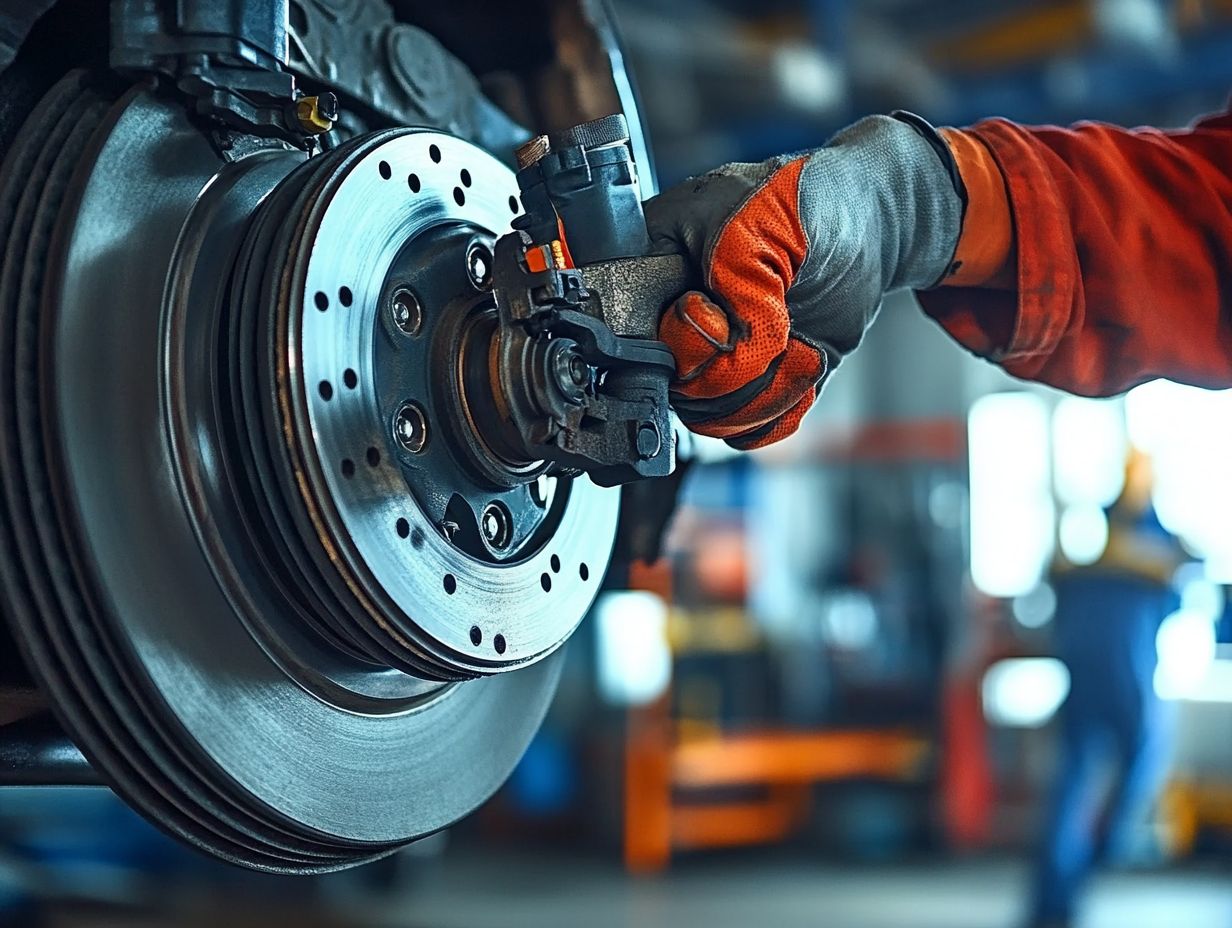
Some common signs of brake problems include squeaking or grinding noises, a vibrating or pulsating brake pedal, and a soft or spongy brake pedal. Additionally, keep an eye out for a dashboard warning light for the brakes. Recognizing these signs that your car needs brake replacement can help you address issues with brake pads, rotors, or brake fluid early on.
What should I do if my brakes are making strange noises?
Don’t ignore those strange noises! If your brakes are squeaking, grinding, or making other unusual sounds, get your brakes checked by a mechanic right away. These noises can indicate worn brake pads or issues that may lead to more serious problems if not addressed quickly.
How often should brake pads be replaced?
The frequency of brake pad replacement varies depending on your driving habits and the type of brake pads you have. As a general rule, brake pads should be replaced every 50,000 miles. However, if you often drive in stop-and-go traffic or tow heavy loads, you may need to replace them more frequently.
What are some common repairs for brake problems?
Common repairs for brake problems include replacing worn brake pads and rotors, changing old brake fluid, and repairing or replacing damaged brake lines. To avoid these issues, it’s helpful to know how to prevent common brake repairs. In more serious cases, the entire brake system may need replacement.
How can I prolong the life of my brake system?
To prolong the life of your brake system, have your brakes inspected regularly and replace worn brake pads and rotors as needed.
Also, follow the manufacturer’s recommended maintenance schedule for changing brake fluid.
What should I do if my brake pedal feels soft or spongy?
If your brake pedal feels soft or spongy, it may indicate a problem with the brake lines or a leak in the brake system.
Make sure to have this checked by a mechanic immediately, as it can affect your ability to stop your vehicle safely.

